

¿Qué necesita?’: Felix Fraga remembered as advocate for Houston’s Mexican-American community
“Early Saturday morning, Jose Sierra walked into the Baker Ripley House on Navigation to ask for information on the funeral services of Felix Fraga, a former city councilman and lifelong community advocate who devoted his career to address the needs of Houston’s Mexican-American residents…”
Hispanic and Latino professionals feel overlooked and underrepresented in corporate America, new study finds
“…The study notes that while Hispanics and Latinos make up 19% of the US population they only represent about 8% of the professional labor force. And within corporate America, only 10% of managers and 5% of executives identify as Hispanic or Latino/a…”
https://www.aol.com/hispanic-latino-professionals-feel-overlooked-213312572.html
Facts on Latinos in the U.S.
“There were 62.5 million Latinos in the United States in 2021, accounting for approximately 19% of the total U.S. population. In 1980, with a population of 14.8 million, Hispanics made up just 7% of the total U.S. population…”
https://www.pewresearch.org/hispanic/fact-sheet/latinos-in-the-us-fact-sheet/
Mexican American Proarchives Annual report on Mexican American Professionals for 2021
The American Community Survey is an annual survey administered by the federal government to help local officials and community leaders and businesses understand the changes that take place in their communities. It includes percentages of our population’s graduate school attainment and the employment of Mexican Americans in various occupations. These important factors influence the allocation of federal resources. Mexican American Proarchives uses the data provided by the American Community Survey to better understand how Mexican Americans compare to the general population.
The primary goal of Mexican American Proarchives is to inform its readers of the percentage of Mexican Americans who obtain a graduate or professional degree. It is the main indicator of individuals employed in professions which require a degree; for example, doctors, teachers, etc. Mexican Americans are considered an underrepresented minority because their percentage of professionals when compared with the general population is very low.
For the year 2021 the results are as follows when Mexican Americans are compared to the total population
EDUCATIONAL ATTAINMENT
GRADUATE OR PROFESSIONAL DEGREE

Comparison of years 2020 and 2021
Here are some examples
The following is a mix of occupations in which Mexican American both underrepresented and over represented.
Bar graph shows the comparison between the total population vs Mexican Americans in:
MANAGEMENT, BUSINESS, SCIENCE, AND ARTS OCCUPATIONS
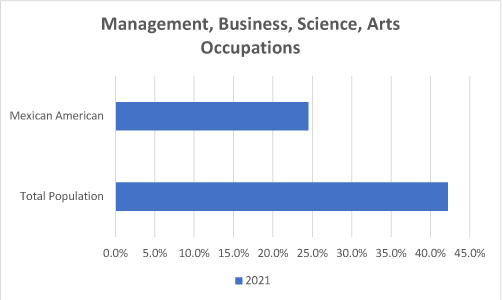
The following bar graphs show occupations in which Mexican Americans are employed at a higher percentage than the total population.
SERVICE OCCUPATIONS
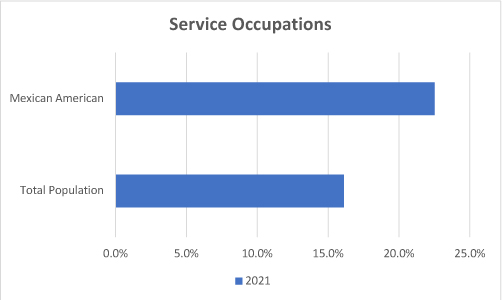
NATURAL RESOURCES, CONSTRUCTION, AND MAINTENANCE OCCUPATIONS
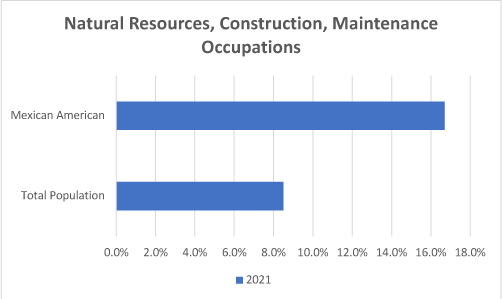
PRODUCTION, TRANSPORTATION, AND MATERIAL MOVING OCCUPATIONS
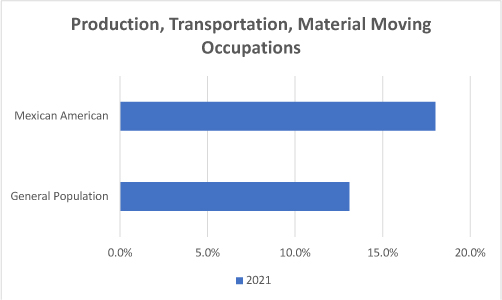
INDUSTRY
AGRICULTURE, FORESTRY, FISHING AND HUNTING, AND MININING
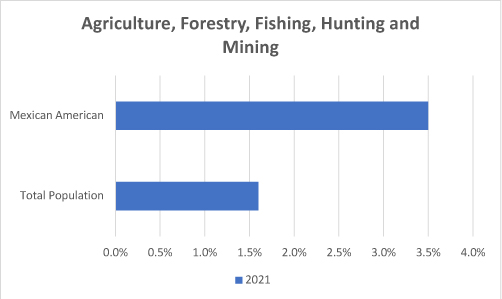
RETAIL TRADE

Lastly, Mexican Americans are also poorly represented in,
MANAGEMENT, BUSINESS, SCIENCE, AND ARTS OCCUPATIONS
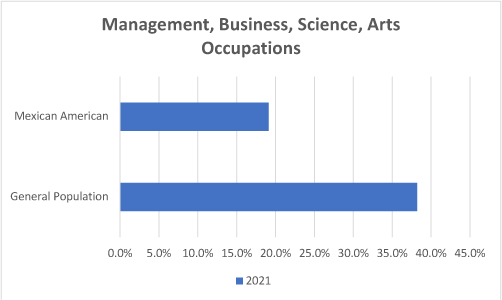
Key facts about U.S. Latinos for National Hispanic Heritage Month
“…The U.S. Hispanic population reached 62.5 million in 2021, up from 50.5 million in 2010. The 19% increase in the Hispanic population was faster than the nation’s 7% growth rate, but slower than the 23% increase in the Asian population. In 2021, Hispanics made up nearly one-in-five people in the U.S. (19%) – the 50 states and the District of Columbia. This is up from 16% in 2010 and just 5% in 1970…”
Texas now more demographically diverse, 2020 Census count shows
“A majority of the Texas population is now made up of people identifying as racial and ethnic groups other than white, according to information released Aug. 12 by the U.S. Census Bureau. The information is based on the 2020 Census count and will be used by state legislators to draw up new political districts this fall.
A 15.9 percent increase in population netted Texas two additional members in Congress. The areas they will represent will be determined during a fall special session of the Texas Legislature.
The total population in Texas is now 29,145,505. According to the 2020 Census, the population is split into the follow percentages among racial and ethnic groups:
- White (non-Hispanic) — 39.8 percent, 11,584,597, up 187,252 from 2010
- Hispanic — 39.3 percent, 11,441,717, which is 1,980,796 more than in 2010
- Black or African American — 11.8 percent, 3,444,712, an increase of 557,887 from 2010
- Asian — 5.4 percent, 1,561,518, an increase of 613,092 from 2010…
- https://www.dailytrib.com/2021/08/13/texas-now-more-demographically-diverse-2020-census-count-shows/
The new Latino landscape The swift growth of U.S. Latinos is reshaping big states and small towns. Meet the faces of a new era.
‘In New Hampshire, a Roman Catholic church where Irish and French Canadian immigrants used to worship now has the state’s largest Latino congregation. In the Deep South, a county in Georgia is one of the nation’s top 10 in diversity. Hispanics accounted for over half of the nation’s population growth in the last decade. This is not just reflected in larger cities, but in mountain towns, Southern neighborhoods and Midwestern prairies. “The Latino population has been dispersing across the United States for years — a reflection of where the nation’s population is moving and where opportunities are located,” said Mark Hugo Lopez, director of race and ethnicity research at the Pew Research Center…”
The new Latino landscape The swift growth of U.S. Latinos is reshaping big states and small towns. Meet the faces of a new era.
“…Hispanics accounted for over half of the nation’s population growth in the last decade. This is not just reflected in larger cities, but in mountain towns, Southern neighborhoods and Midwestern prairies. “The Latino population has been dispersing across the United States for years — a reflection of where the nation’s population is moving and where opportunities are located,” said Mark Hugo Lopez, director of race and ethnicity research at the Pew Research Center…”
4 ways to move to Canada under CUSMA
“U.S. and Mexican citizens can work and conduct business in Canada under CUSMA, here are your options.
Eligible U.S. and Mexican citizens can skip some of the red tape to come work or conduct business in Canada.
The Canada-United States-Mexico Agreement (CUSMA) allows workers, traders, and investors to come to Canada without going through the Labour Market Impact Assessment (LMIA) process. Before July 1, 2020, CUSMA was known as the North American Free Trade Agreement, or NAFTA…”
https://www.cicnews.com/2020/10/4-ways-to-move-to-canada-under-cusma-1016005.html#gs.hxnj6b
Unemployment rose higher in three months of COVID-19 than it did in two years of the Great Recession
“…Hispanic women had the highest rate of unemployment in May (19.5%), compared with other women or men among the nation’s major racial and ethnic groups. The unemployment rate among white women jumped nearly fivefold, climbing from 2.5% in February to 11.9% in May. A steep increase in the unemployment rate among Asian women also pushed their unemployment rate in May (16.7%) to near parity with the unemployment rate among black women (17.2%)…”
Mexico’s coronavirus-skeptical president is setting up his country for a health crisis
“…As Mexico fast approaches what’s highly likely to be a large coronavirus outbreak, the country’s leadership — mainly its president — mostly insists that everything is fineIn speech after speech, President Andrés Manuel López Obrador, known by his nickname AMLO, tells Mexicans they shouldn’t fear Covid-19, even as hundreds of thousands of people have confirmed infections worldwide. Despite warnings from global health officials, he continues to hold political rallies, kiss supporters, and request that Mexicans go out shopping to prop up the country’s sputtering economy during a global slowdown.“Live life as usual,” he said in a video posted to Facebook on March 22, showing him outside at a restaurant. “If you’re able and have the means to do so, continue taking your family out to eat … because that strengthens the economy.”…”
https://www.vox.com/2020/3/26/21193823/coronavirus-mexico-andres-manuel-lopez-obrador-health-care
Young Latino Professionals of Kansas City
“Young Latino Professionals (YLP) is a network of more than 350 passionate individuals from all backgrounds and various industries who come together to shape their communities while developing as leaders. YLP provides opportunities for young leaders to engage with like-minded peers through social and professional networking, philanthropic outreach and professional development. Our organization recognizes that Greater Kansas City’s professional community is constantly growing and so are we!…
Mario Rodriguez Executive Director
“Mario Rodriguez, an aviation expert with over 29 years of experience in the private and public sectors, was appointed as the executive director of the Indianapolis Airport Authority in 2014. Prior to the Authority, Rodriguez successfully transformed the Long Beach Airport into an award-winning organization with world-class facilities and exceptional financial performance. Rodriguez also served as president of the California Airports Council, and he sits on the board of Airports Council International (ACI). In the past he served at airports..”
Link to article
New Jobs Report Shows Record Unemployment Lows for Hispanics, Women May 3rd, 2019
“…At 4.2% the Hispanic unemployment rate is the lowest it has ever been, and at 3.1% the adult women unemployment rate reached its lowest since 1953…”
Link to article
Against Trump’s wishes, Mexican professionals keep visas in new trade deal
By Anita Kumar And Franco Ordoñez
August 28, 2018 04:35 PM
Updated August 28, 2018 11:12 PM
WASHINGTON
Tens of thousands of Mexican professionals who come to work in the United States will be able to keep their visas as part of the new U.S.-Mexico trade agreement, the Mexican government says, delivering a political loss to the Trump administration who sought to slash the number of visas as part of NAFTA re-negotiations.
The Mexican Economy Ministry told McClatchy that…”
Link to article
Mexican Americans’ many routes to finding their own national identities
“…Alfredo Corchado is messing with my head, forcing me to think hard about something I had neatly packed away: What it means to be Mexican American. What are friends for if not to turn your world upside down?
As a reporter — currently for the Dallas Morning News, and earlier at the El Paso Herald-Post and the Wall Street Journal — Corchado has always been a good storyteller. But when he began writing books, he had to learn to tell his own story. He has become good at that, too…”
Link to article
Upwardly Mobile
The number of Mexican-born professionals living in the United States has more than doubled since 1995. They’re not the undocumented workers you see in evening-news mug shots or aerial photographs of a littered and barren desert. They’re college graduates — some with multiple degrees — who join their blue-collar counterparts in their journeys north…
Link to article
Being Mexican in NYC with Carlos Menchaca
New York City Councilman Carlos Menchaca became the first Mexican-American elected in the city when he won his Brooklyn seat in 2013. In Sunset Park and Red Hook, many of Menchaca’s constituents are ethnically Mexican as well, making up part of what he says is a majority foreign-born district. To mark the Cinco de Mayo celebration of Mexican culture, Menchaca talked to City & State about spending summers on a farm south of the border, the best Mexican restaurant in the city and how he has to deny working with President Donald Trump…
Link to article
Autentico: The Definitive Guide to Latino Career Success
R Rodriguez, AT Tapia – 2017
… When Judith Turnock and I wrote Cracking the Corporate Code we were aware that although
the book was about the success of the thirty-two African-Americans we cited, interest in the book
would go far beyond that group. … FRIDA KAHLO, Mexican painter W hy of whom this …
Link to book preview
Mexican American Proarchive: Annual Report on Mexican American Professionals
News from the census American Community Survey is generally good for the 2015 year. Mexican American college enrollment was up from 18.7% to 18.9% in the 2014 and 2015 years. Graduate or professional degree attainment was also up from 2.9% to 3.0%. The number of bachelor’s degrees granted to Mexican American students rose from 7.6% in 2014 to 7.8% in 2015.


In spite of these gains, Mexican Americans still remain at the bottom of the ladder when it comes to earning a bachelor’s degree. Even after broadening the group to Latinos or Hispanics, this group still lags behind. According to the Pew Hispanic Center: “As of 2014, among Hispanics ages 25 to 29, just 15% of Hispanics have a bachelor’s degree or higher. By comparison, among the same age group, about 41% of whites have a bachelor’s degree or higher (as do 22% of blacks and 63% of Asians).” Pew reports that the main reasons for this low graduation rate is that Hispanics are less likely “to enroll in a four-year college, attend an academically selective college and enroll full-time.”
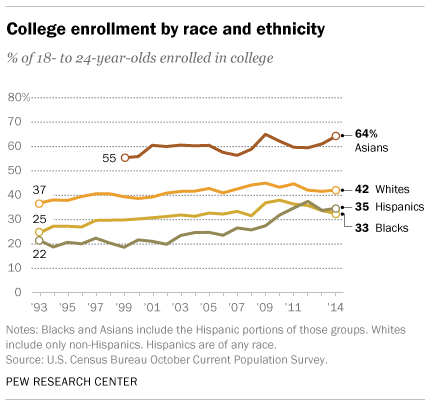
Also in the good news column, the University of California will continue to push for a greater number of underrepresented minorities; namely, Chicano/Latino students whose resident freshmen numbers rose from 2.7% to 32.3% of admitted California freshmen. In other good news, the proportion of Chicano/Latino students transferring from community colleges increased to 29.3% from 26.8% for 2015.
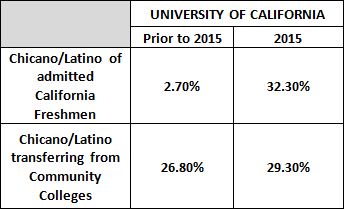
Occupations, including those in management, business, science, and art, fared better for Mexican Americans. The number of Mexican Americans filling these occupations rose from 17.4% in 2014 to 17.5% in 2015.

The total number of Hispanics filling these occupations was 16.1% in 2015, a bit lower than Mexican Americans specifically.
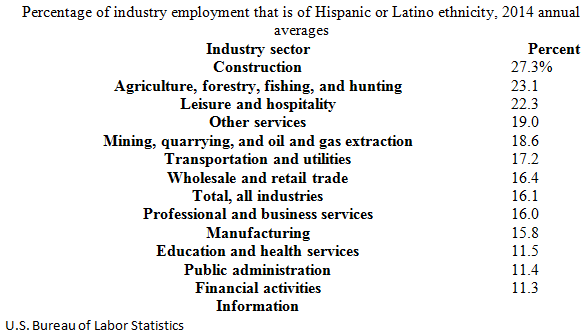
The report shows that industrial employment for Mexican Americans remained the same for 2014 and 2015 at 10.2%.
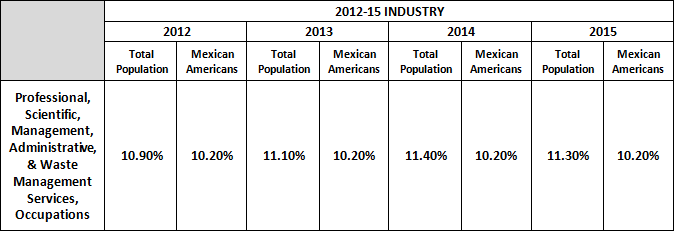
The figures for Hispanic or Latino employment for 2015 and 2016 show a healthy increase.
According to the Pew Hispanic center, “Construction, professional and business services, health services, financial services and food services…showed healthy gains.” Most of the jobs gained by native-born Hispanic workers were in manufacturing, mostly durable goods (82,000 Hispanic workers in this industry), followed by wholesale and retail trade (79,000), publishing, broadcasting, communication and information services (55,000), and construction (54,000).
Foreign-born Hispanics had the most job gains in construction (417,000), followed by business and professional services (179,000). Together, those two industries accounted for almost three-quarters (74%) of all jobs gained by foreign-born Latinos between 2005 and 2006.
The business and professional services sector, which ranges from management and technical services to janitorial, landscaping, and waste management services, is also a key employer for non-Hispanic workers. Of the total increase in employment in 2005-06, non-Hispanic workers accounted for 410,000 employees in the industry, native-born workers 327,000, and foreign-born workers 83,000.
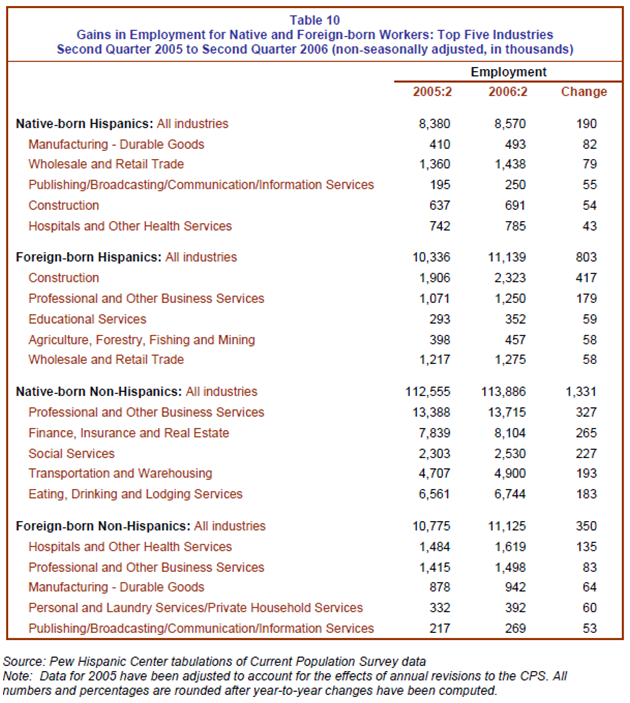
Sources
- Census Bureau, Selected Population Profile in the United States: 2015
- Pew Research Center
- University of California
- Bureau of Labor Statistics



